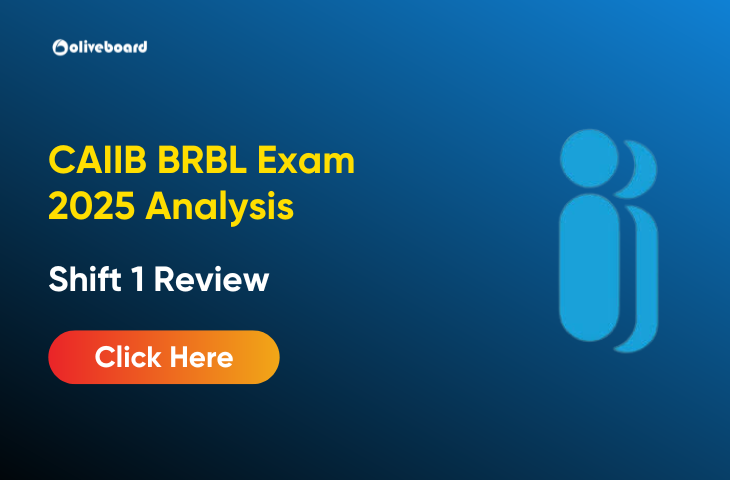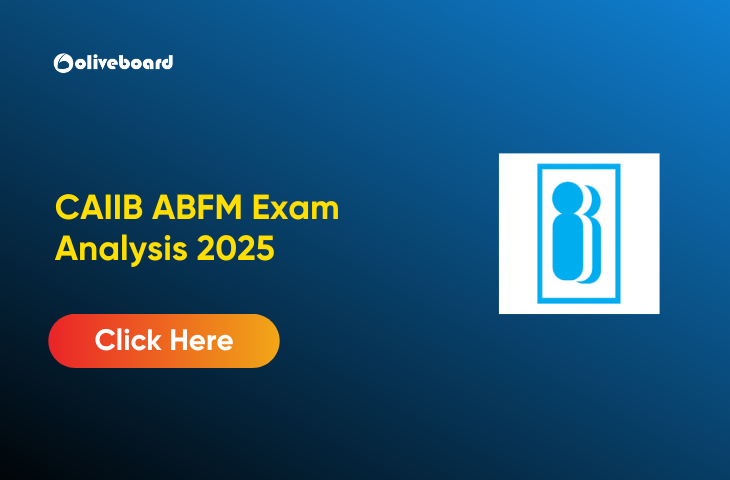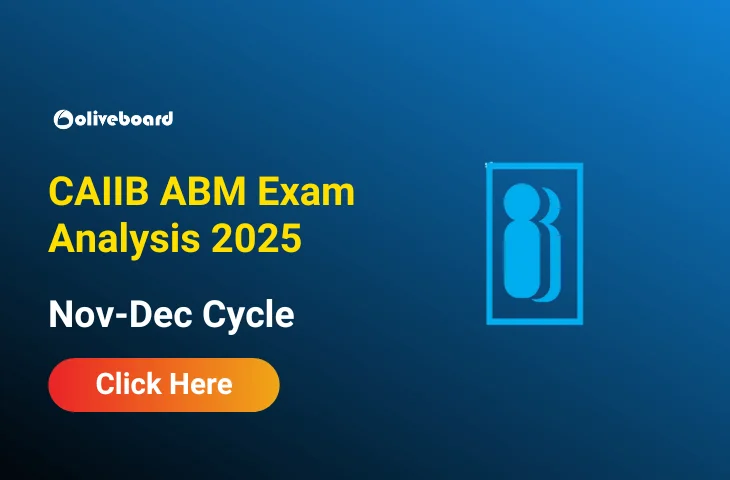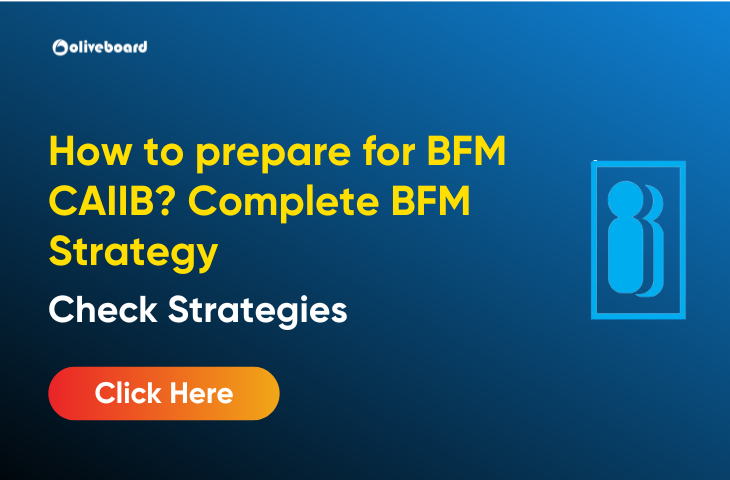CAIIB BFM Preparation Strategy
The CAIIB BFM 5 Days Strategy is a focused approach to help you prepare for the Banking Financial Management (BFM) paper of the CAIIB exam. With just five days to prepare, you need a structured plan that covers the key topics effectively and efficiently. This article covers a simple and practical strategy to help you score well in the BFM paper.
What is CAIIB BFM?
The CAIIB (Certified Associate of Indian Institute of Bankers) exam includes the Banking Financial Management (BFM) paper. BFM focuses on understanding how banks manage their financial activities, including topics like international banking, risk management, treasury operations, and balance sheet management.
How to Prepare for CAIIB BFM?
Bank Financial Management (BFM) is one of the core subjects in the Certified Associate of Indian Institute of Bankers (CAIIB) exam. Preparing for BFM requires a clear strategy and focused study approach. Here’s a structured guide to help you succeed in this exam:
1. Understand the Syllabus
- Module A: International Banking
- Module B: Risk Management
- Module C: Treasury Management
- Module D: Balance Sheet Management
It’s important to thoroughly understand each module and identify key topics. Allocate more time to modules that have a higher weightage in the exam.
2. Focus on Key Topics
Some of the most important topics in BFM are:
- Exchange Rate Mechanism: Learn about foreign exchange rates, forward rates, spot rates, and the factors influencing them.
- Risk Management: Focus on types of risks (credit risk, market risk, operational risk), and tools used to manage them.
- Treasury Operations: Understand the role of treasury in banks, its functions, and risk management techniques.
- Capital Adequacy: Learn the Basel norms and their impact on the banking system.
- Balance Sheet Management: Focus on liquidity management, asset-liability management (ALM), and profitability.
3. Practice Numericals
BFM has a significant number of numerical questions, especially from topics like:
- Exchange Rate Calculations
- Interest Rate Risk
- Duration and Convexity
- Risk-Weighted Assets (RWA)
Make sure to practice these numericals regularly, as they carry a substantial portion of marks.
4. Time Management
The BFM paper can be time-consuming due to the length of questions and numericals. Here are some tips:
- Break down your study schedule into manageable daily goals.
- Focus on 2-3 topics each day.
- Practice solving questions within a set time to improve speed.
5. Use Conceptual Study
Don’t just memorize concepts, understand them. The BFM exam tests your ability to apply concepts in real-life scenarios, especially in case studies.
6. Take Mock Tests
Mock tests are crucial for your preparation. They help you:
- Familiarize yourself with the exam format.
- Identify weak areas.
- Improve time management skills.
Take mock tests regularly and review your answers carefully.
7. Revise Regularly
Revision is key to retaining what you’ve learned. Allocate the last few weeks before the exam for revision. Focus on key concepts, important formulas, and high-weightage topics.
8. Join Study Groups or Classes
- Study groups can help clarify doubts and provide different perspectives on difficult topics.
- Consider joining online or offline coaching classes that focus specifically on CAIIB BFM preparation. They can offer structured guidance and expert insights.
9. Follow a Study Plan
Create a detailed study plan that covers all the modules and provides enough time for revision. An example could be:
- Week 1-2: Module A (International Banking)
- Week 3-4: Module B (Risk Management)
- Week 5-6: Module C (Treasury Management)
- Week 7-8: Module D (Balance Sheet Management)
- Week 9-10: Practice mock tests and revise.
10. Stay Consistent and Motivated
Preparing for BFM requires consistent effort. Stay motivated, keep track of your progress, and focus on clearing each module with a good understanding of concepts
CAIIB 2024 – Overview
Candidates who will be appearing for the examination must be aware of the overall details of the CAIIB. We have mentioned below the overview details of the CAIIB 2023 for the candidates.
| Name of organization | Institute of Banking and Finance |
| Institution | Indian Institute of Banking & Finance (IIBF) |
| Name of Examination | CAIIB exam |
| Eligibility | Members Only |
| Mode of Application | Online |
| Mode of exam | Online written exam |
| Exam conducted | Twice a year |
| Official website | iibf.org.in |
Essential Units and Study Materials for Risk Management Mastery
Preparing for the BFM CAIIB exams requires a strategic approach to studying the core concepts of risk management and banking. The following sections outline important units, additional study materials, and focus areas to ensure effective preparation.
1. Important Units to Focus On
| Unit Number | Description | Difficulty Level |
| Unit 11 | Basics of Risk Management | Easier |
| Unit 12 | Introduction to Banking Concepts | Easier |
| Unit 14 | Advanced Risk Measurement Techniques | Moderate |
| Unit 15 | Risk Assessment and Management | Requires More Focus |
| Unit 16 | Financial Instruments and Their Risks | Requires More Focus |
| Unit 17 | Treasury Management | Moderate |
- Key Note: Units 11 and 12 are foundational and considered easier to grasp. In contrast, Units 15 and 16 contain numerical problems that demand additional study time.
2. Additional Study Materials
| Material Type | Description |
| PDFs | Comprehensive notes on each unit, highlighting key concepts. |
| Numerical Exercises | Practice problems, especially for Units 15 and 16. |
| Past Exam Papers | Previous years’ question papers to familiarize with exam patterns. |
- Key Note: Utilizing these materials can greatly enhance understanding of complex topics.
3. Repeated Topics Across Units
| Topic | Units Covered |
| Risk Management | Units 14, 15, 16 |
| Treasury Management | Units 14, 17 |
| Derivatives | Units 14, 16 |
- Key Note: Topics like risk management and treasury management recur across various units. Reviewing these thoroughly is vital for holistic understanding.
4. Focus Areas for In-Depth Understanding
| Focus Area | Key Concepts |
| Basel III Framework | Tier 1 and Tier 2 capital, liquidity requirements |
| Types of Risks | Credit risk, equity risk, liquidity risk |
| Numerical Problems | Altman Z-score, haircuts, duration-based calculations |
- Key Note: Prioritize understanding the Basel III framework, as it is crucial for risk management concepts.
5. Important Models to Study
| Model | Key Aspects Covered |
| Model B | Stress testing, capital charge calculations |
| Model D | Liquidity risk management |
- Key Note: Familiarity with these models will aid in understanding risk management concepts more effectively.
6. Common Themes Across Units
| Theme | Units Involved |
| Organizational Behavior | Units 11, 14 |
| Risk Identification | Units 12, 14, 15 |
| Measurement Techniques | Units 15, 16 |
- Key Note: Understanding overlapping themes will assist in answering questions that may be derived from multiple units.
7. Numerical and Formula-Based Questions
| Units | Focus |
| Units 24-28 | Heavy emphasis on formulas related to risk and asset management. |
- Key Note: Memorize and practice formulas related to risk and asset management for these units.
8. Strategy for Preparation
| Preparation Steps | Description |
| Identify Important Topics | Start with guaranteed important topics. |
| Review Common Concepts | Look for themes that recur across different units. |
| Daily Study Plan and Revision | Implement a structured daily study routine. |
- Key Note: Consistent revision and daily planning will greatly enhance your retention and understanding of concepts.
BFM CAIIB: Important Topics
The Banking Financial Management (BFM) paper in the CAIIB exam covers a range of critical topics essential for understanding banking and risk management. Below is a breakdown of important topics along with their significance.
1. Risk Management
| Subtopics | Key Concepts | Relevance |
| Risk Identification | Types of risks (credit, market, operational) | Understanding various risks is essential for effective management. |
| Risk Measurement | Techniques like Value at Risk (VaR) | Helps in quantifying risk exposure. |
| Risk Mitigation | Strategies for minimizing risk | Essential for safeguarding the bank’s assets. |
- Key Note: Risk management is a core area that underpins all banking operations.
2. Basel III Framework
| Subtopics | Key Concepts | Relevance |
| Capital Adequacy | Tier 1 and Tier 2 capital | Ensures banks have enough capital to absorb losses. |
| Liquidity Requirements | Liquidity Coverage Ratio (LCR) | Vital for maintaining financial stability. |
| Leverage Ratio | Limits excessive borrowing | Reduces the risk of bank insolvency. |
- Key Note: Familiarity with Basel III is crucial for compliance and risk management.
3. Financial Instruments
| Subtopics | Key Concepts | Relevance |
| Types of Financial Instruments | Bonds, derivatives, stocks | Understanding instruments is key for effective trading and investment. |
| Valuation Methods | Present value, discounted cash flow | Essential for evaluating investment opportunities. |
| Market Risks | Interest rate risk, credit risk | Helps in assessing the potential impact on financial performance. |
- Key Note: Knowledge of financial instruments aids in strategic decision-making.
4. Treasury Management
| Subtopics | Key Concepts | Relevance |
| Cash Management | Techniques for optimizing cash flow | Critical for maintaining liquidity. |
| Asset-Liability Management | Strategies for managing financial risks | Ensures balance between assets and liabilities. |
| Funding Strategies | Sources of funding, debt issuance | Important for maintaining operational efficiency. |
- Key Note: Effective treasury management is vital for overall financial health.
5. Derivatives
| Subtopics | Key Concepts | Relevance |
| Types of Derivatives | Futures, options, swaps | Used for hedging and speculation. |
| Pricing Models | Black-Scholes model, binomial model | Essential for accurate valuation of derivatives. |
| Risk Management with Derivatives | Hedging strategies | Important for mitigating risk in volatile markets. |
- Key Note: Derivatives play a crucial role in risk management and financial strategies.
6. Asset Management
| Subtopics | Key Concepts | Relevance |
| Portfolio Management | Techniques for optimizing investment portfolios | Important for maximizing returns and minimizing risk. |
| Performance Evaluation | Metrics like Sharpe ratio, alpha, beta | Essential for assessing portfolio effectiveness. |
| Regulatory Framework | Guidelines for asset management | Ensures compliance with legal standards. |
- Key Note: Effective asset management contributes to the bank’s profitability.
7. Emerging Banking Trends
| Subtopics | Key Concepts | Relevance |
| Fintech Innovations | Impact of technology on banking | Understanding trends is vital for competitive advantage. |
| Digital Banking | Online banking services, mobile payments | Key for meeting customer demands in the digital age. |
| Regulatory Changes | Evolving regulations in banking | Staying compliant is essential for operational success. |
- Key Note: Keeping abreast of emerging trends is crucial for future growth and adaptation.
Study Resources and Preparation Tips
To effectively prepare for the CAIIB BFM syllabus, candidates should utilize a combination of study resources, including recommended Oliveboard, online courses, and practice tests to enhance their understanding of key concepts. Additionally, creating a structured study plan and dedicating consistent time for revision can significantly improve retention and performance in the examination.
| Resource Type | Details |
| Online Resources | – Video lectures and webinars by experienced educators. |
| – Study materials and PDFs available online for banking exam preparation. | |
| Mock Tests | – Regularly take mock tests to evaluate understanding and readiness. |
| Time Management | – Set specific hours each day for focused study. |
7-Day Preparation Plan for BFM CAIIB
The 7-Day Preparation Plan for BFM CAIIB is a clear and organized way for students to study important topics in just one week. By concentrating on key units, practicing numerical problems, and reviewing regularly, students can improve their understanding and feel more confident for the exam.
Day 1: Understanding the Exam Structure and Key Topics
- Activities:
- Familiarize yourself with the BFM syllabus and exam pattern.
- Identify important units: Units 11, 12, 14, 15, 16, and 17.
- Create a list of critical topics and concepts for each unit.
- Study Hours: 3-4 hours
- Focus:
- Understanding the weightage of different units.
- Setting specific goals for each day of the week.
Day 2: Units 11 and 12
- Activities:
- Unit 11: Banking Structure
- Read and take notes on the core concepts.
- Solve practice questions.
- Unit 12: Financial System
- Focus on understanding key components and their interrelationships.
- Work on numerical problems.
- Unit 11: Banking Structure
- Study Hours: 4-5 hours
- Focus: Ensure clarity on fundamental concepts.
Day 3: Units 14 and 15
- Activities:
- Unit 14: Financial Instruments
- Review important instruments and their applications.
- Solve relevant practice questions.
- Unit 15: Risk Management
- Study the basics of risk management and common risk types.
- Work on numerical problems related to risk assessment.
- Unit 14: Financial Instruments
- Study Hours: 4-5 hours
- Focus: Grasp the significance of financial instruments and risk management.
Day 4: Units 16 and 17
- Activities:
- Unit 16: Treasury Management
- Understand the objectives and strategies in treasury management.
- Solve case studies or practical problems.
- Unit 17: Investment Banking
- Review key concepts related to investment banking.
- Engage with practice questions.
- Unit 16: Treasury Management
- Study Hours: 4-5 hours
- Focus: Develop a strong understanding of treasury and investment banking concepts.
Day 5: Advanced Topics and Models
- Activities:
- Review advanced topics:
- Basel III framework.
- Credit, equity, and liquidity risks.
- Study important models related to risk management (Model B and Model D).
- Review advanced topics:
- Study Hours: 4-5 hours
- Focus: Ensure comprehension of critical regulations and models used in risk management.
Day 6: Revision and Practice
- Activities:
- Revise all studied units.
- Focus on numerical and formula-based questions.
- Take practice tests to simulate the exam environment.
- Study Hours: 4-5 hours
- Focus: Reinforce memory and identify weak areas through practice.
Day 7: Final Revision and Mock Test
- Activities:
- Review key formulas and concepts from all units.
- Take a final mock test to assess overall preparedness.
- Analyze your performance and focus on any remaining weak areas.
- Study Hours: 3-4 hours
- Focus: Confidence building and final clarifications.
Tips for Effective Preparation
- Daily Study Sessions: Aim for 3-5 hours of focused study each day, taking regular breaks to enhance retention.
- Use Study Materials: Utilize PDFs, online resources, and textbooks for comprehensive understanding.
- Group Study: Engage with peers for discussions on difficult concepts to deepen understanding.
- Stay Healthy: Ensure you are well-rested, eat healthily, and stay hydrated to maintain optimal focus and concentration.
- CAIIB Electives Exam Analysis 2025, December All Paper Review

- CAIIB BRBL Exam Analysis 2025, December Cycle Review

- CAIIB ABFM Exam Analysis 2025, 13th December Review

- CAIIB BFM Exam Analysis 2025, 7th December Difficulty Level

- CAIIB ABM Exam Analysis 2025, All Shifts, 30th November

- Difference Between JAIIB & CAIIB, Eligibility, Exam Pattern


Hello there! I’m a dedicated Government Job aspirant turned passionate writer & content marketer. My blogs are a one-stop destination for accurate and comprehensive information on exams like Regulatory Bodies, Banking, SSC, State PSCs, and more. I’m on a mission to provide you with all the details you need, conveniently in one place. When I’m not writing and marketing, you’ll find me happily experimenting in the kitchen, cooking up delightful treats. Join me on this journey of knowledge and flavors!
